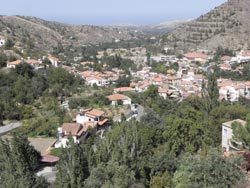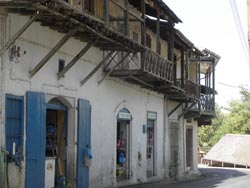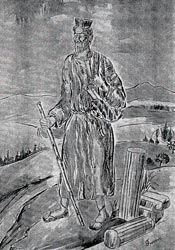You are a child of Klarios
And a grandchild of Olympus
You bathe in green
With the nightingale as company
Galata is located 60 kilometres west of Nicosia in the beautiful
valley of Solea. It has an altitude of 620 metres above sea
level.

It is built in the two banks of the River Klarios that crosses
through it and it is literally drowning in green. It is conjunct
with the neighbouring community of Kakopetria. Both these twin
hamlets receive thousands of tourists throughout the year.
Galata is famous for its tasty fruits that it produces in
large quantities, especially apples of every variety, apricots,
peaches, cherries, damsons, grapes, and others, as well as
a variety of fresh vegetables.
‹‹ If one wants to enjoy a few unforgettable summer moments
in Galata, he / she must sit at the village's plaza. There,
in the shadow of the age-old oak and the plane-trees with the
Kargotis (Klarios) River, he / she will have unforgettable
moments.
The houses of Galata -both the modern and the traditional
ones -possess grace and beauty. One is particularly impressed
by the wooden balconies and the wooden stairs of the old, traditional
houses.

The tiled, inclined roofs, the local stone with which the
houses' walls are made, the latches and bolts, the gateways
with their wooden transoms, all these are unfeigned witnesses
of contrived folkloric architecture, which is unfortunately
dying away as time goes by.
Chiefly however, what is found here is an excellent cultural
heritage. The six Byzantine churches with the pyramid-like
roofs and their rectangular tiles present to the visitor an
unparalleled Byzantine architecture, mainly from the 16 th
century››. (Journeys in Cyprus, G and M Karouze).
The History and Tradition regarding Galata -- the
village's name
In very old times, there where legend
merges with history, in the "Esso-Galata venue west of today's village, some
shepherds lived along with their flocks. The people who lived
in the lower lands, the "katochorites" (lower-village
inhabitants), went there in order to buy milk. The people would
say amongst them "lets go over there to the ‹galataes›
(plural, milkmen) and buy some milk". Out of "galataes",
always according to tradition, came the name Galata.
Another tradition reports that the
first settlers came from Galatia of Asia Minor and were named "Galates" (Byzantine
era). So their small settlement was named Galata.
In his Chronicle (Annals), Leontios
Machaeras reports that Galata belonged to the feud of the "Regas" (king)
since 1196.
Galata is again mentioned by Leontios Machaeras in his Chronicle:
‹‹ … Learn…. These Maria said to me…. who took care of Mr.
Erricos de Giblet in the village of Galata… ››
Thus we come to the conclusion that during the Frank Domination
era Galata belonged to the De Giblet family.
In Mediaeval maps Galata is found marked under the name Golata
and Galata (Iacomo Franco 1570, Galata).
 This is what the Russian traveller,
Vasiliev Barksy, wrote in 1735 regarding Galata: This is what the Russian traveller,
Vasiliev Barksy, wrote in 1735 regarding Galata:
He first visited Galata and then the village's
monastry of Podithou as he prescripes it.Then he returned
back to the village were he spend the night.
‹‹ I went to the nearest village, named Galata, and spent
the night close to a Christian along with my companions, which
were priests. Let it be known that the villages of Solea have
very few Muslim inhabitants, the majority being Greek Orthodox
Christians, with many churches and priests. This village is
the most beautiful of all. It has many fruit-bearing trees
and running water and it is located next to the aforementioned
river Klarios ››.
The Village of "Lampadou"
It is not known where exactly the village
of "Lampadou" was
built. However, the inhabitants of Galata as well as those
of the surrounding villages -by tradition -starkly believe
that this village or small settlement was located close to
the country church of St. George the "Perachorites",
east of Kakopetria and to the left of the tourist road to Troodos.
"Lampadou" or "Lampadis" or "Lampadistos" has
been the birthplace of two of our Church's Saints, St Herakleidios
and St. John the "Lampadistes" (the Illuminator).
The following reasons reinforce and confirm the view that
Lampadou was located in the aforementioned area.
• According to St. John the Illuminator's "Akolouthia" (service)
of 1667, he came from ‹‹ the hamlet of Lampadou of the Galaton
district ››.
• In an unpublished manuscript
(Φ13 β) it was mentioned that: ‹‹ He was a Cypriot -St. John
the Illuminator -from the region of the Solea district, from
the village Lampadou ››.
• The Russian traveller
Barsky who in 1735 spent one night in Galata, during his
tour ‹‹ in all the monasteries of Cyprus ›› mentions: ‹‹
John -a saintly man -the Illuminator from the village of
Lampadis, where the Saint was born and which now has been
abandoned as I have ascertained when I was in Solea ››.
• One of the "Aposticha" (types
of verses) that refers to St. Herakleidios goes like this:
« Τόπους αμειβόμενος οι του Σωτήρος Απόστολοι προς Σολέαν
ιθύνονται και δόξαν κηρύττοντες Ιησού του Λόγου , άχρι της
Λαμπάδου , ένθα και εύρον τον φαιδρόν θείον και πάνσοφον
Ηρακλείδιον , δοχείον καθαρώτατον και μύστην υπάρχοντα Ελληνικής
διαθέσεως , όν διδάξαντες έλεγον , σέβειν ένα Θεόν ημών »,
narrating how the Apostles, preaching the Word of God, came
to Lampadou and taught St. Herakleidios about Christianity.
• In the service of St.
John the Illuminator of 1774, h is mentioned as descending
‹‹ from the village Lampadistou of Solea››.
• Sofronios, the former Metropolitan Bishop of
Leontopolis writes in his 1935 opus "Hagiology of the
Orthodox Church": ‹‹ Saint John the Illuminator, from
Cyprus (October 4 th ). In no hagiographer have I encountered
a memoir of him… He is celebrated in Cyprus, descending from
Lampadou (a village by the hamlet of Galata) and thus having
this name ››.
• At a small distance outside Galata there is a
bridge called "giofyrin t' Aerakleidkiou", that is
bridge of St. Herakleidios.
• There is a venue quite near Galata named "Moutte
tis Lampadou" (nose or peak of Lampadou).
• In the Byzantine churches
of Galata and Kakopetria there are frescoes depicting St.
Herakleidios and St. John the Illuminator.
• ‹‹ Again the mention of a settlement under the
name Lampas in the "district of the Galates" indicates
that the settlement must have been in the Solea region (where
the large village of Galata is) ››. (History of the island
of Cyprus, volume II, Andros Pavlides).
St. Herakleidios
From the Hagiography of St. Herakleidios -and also from other
sources -we can conclude that he was an idolater (heathen)
and a son of a certain Hierokleous or Hierokles, a heathen
priest. It is known that the ancient people in Cyprus, like
the ancient Greeks, believed in the twelve Gods of Olympus.
When the Apostles Paul and Varnavas came to Cyprus in 45 AD
to preach the Nazarene's religion, they passed by Lampadou
that was close to Galata. Here the Apostles met the then young
Herakleidios along with his father who -at that moment -was
offering a sacrifice to the Gods. Hierokles invited them to
take part in the sacrifice. The Apostles refused. They only
asked to be shown the wrote to Pafos.
Hierokles allowed his son, Herakleidios, to escort the Apostles
and show them the way.
As they were walking, the Apostles taught to Herakleidios
the true religion of Jesus Christ and its superiority, in comparison
with the religion he believed in. Herakleidios was thrilled
with the new religion, became a believer, and was baptised.
The Apostles ordained him as the bishop of Tamassos.
St. John the "Lampadistes" (Illuminator
/ torch bearer)
St. John the Illuminator descended from Lampadou, as his surname
reveals, just like St. Herakleidios. ‹‹ … from the renowned
island of Cyprus, from the village of Lampadou in the district
of Galata››. (Costas Myriantheas St John the Illuminator)
He lived during the 11 th century. His parents were the priest
Kyriakos and his mother Anna.
He was nurtured with the essence of the faith and learned
the holy scriptures from an early age. Because of his great
love for God, he dedicated himself wholeheartedly to Him.
When he was 18 years old his parents were pressing him to
be engaged, forgetting that their son was the fruit of their
prayers and pleas.
After the engagement, John decided to break his engagement
and dedicate himself to God. He announced to the parents of
his fiancee his irreversible decision. In spite their bitterness
and their feelings of being insulted, they pretended that they
still had loving feelings for him. They invited him to dinner
and poisoned him and as a result John was blinded. The scene
of this lethal dinner with the poisonous fishes that they offered
to him is depicted in a large portable icon, which is found
in his monastery in Kalopanagiotis.
He was now blind. But he says "If they have taken from
me the eyes of the body, the eyes of the soul exist, so that
I will praise the name of God with greater zeal".
With the help of a servant who had the same name as he did,
he leaves Lampadou and ascends to the monastery of his fellow-villager,
St. Herakleidios.
He lived three years of angelic, ascetic
life "teaching
everyone that -if they want- they are able to live 'close'
to Christ".
He was 22 years old when he delivered
his "snow-white
soul" to the Lord. |